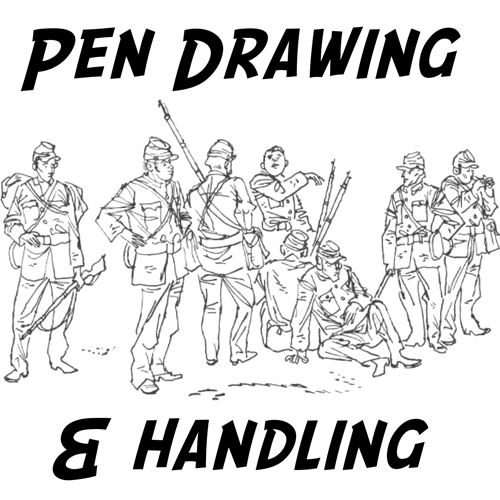Drawing in Pen and Ink and How to Handle Your Pen Correctly
Now comes the time for starting the first actual work in pen drawing; work of the very simplest sort, designed to give one an acquaintance with his instruments and to provide for him a logical starting point from which to advance gradually and consistently, as broader perception and increased manual dexterity are gained.
The beginner must be cautioned not to try to rush ahead too fast; he must be content to master each step as he goes. Just as the student of the piano would find it impossible to render even the simplest composition completely and correctly until thoroughly drilled in the proper preliminary steps, so the student of drawing would find obstacles equally great if he allowed his impatience to lead him to an attempt of a finished drawing of any but the simplest of subjects until such rudimentary exercises as we have provided here had been fairly well mastered.
First of all he must acquire considerable facility in the manipulation of the pen itself, for without such facility satisfactory drawings cannot possibly be made.
It is easier for most of us to handle a pen than to manipulate a brush or a stick of charcoal or crayon, mainly because we arc accustomed to its use in writing. Every bit of practice which one may have had in penmanship, or in writing with the pencil, for that matter, either in or out of school, will be of service. Drawing, however, requires a far greater freedom of movement than does writing. In writing the pen is held in very much the same position constantly; in drawing the position is frequently varied. In writing a comparatively small number of standardized curves and straight lines are combined in a methodical and oft repeated manner; in drawing there is almost no end to the variety in length and direction and character of the lines used or to the methods of combining them. The penman, then, seeks a certain monotonous perfection of stroke; the artist, on the other hand, must acquire the greatest possible versatility in the command of his instrument. He must be able to draw long, sweeping strokes, bold vigorous lines, crisp dashes and delicate dots. He must be able to draw reasonably straight lines and pleasingly curved lines, singly or in combination. And he must have the skill to draw all of these when and where he pleases on his paper, vertically, horizontally or slantwise. He must do so, too, with little conscious effort, so he can have his attention free to give to the development of his composition as a whole.
This does not mean that one must never attempt finished pen drawings until he has absolute control of his pen—a stage which he will doubtless fail to reach anyway. After what seems a reasonable , amount of practice in drawing individual lines and in building simple tones (this amount depending on the natural aptitude and previous experience), the student should go directly to the making of drawings; in these he should continue his pen practice by varying his handling from time to time. He should also experiment with different pens and different papers, and with drawings of various sizes, in the meanwhile keeping up additional pen exercises at spare moments, scratching a few lines or building tones whenever opportunity offers, until a really worth while degree of proficiency has been arrived at.
Now just a word as to the materials for this first work. Not all of those described in the previous chapter are needed; the following are really essential.
1. Several sheets of smooth white paper or Bristol board of convenient size.
2. A medium pen or two such as the Gillott 303 and 404.
3. A penholder and a wiper.
4. A bottle of black drawing ink.
5. Drawing board or other suitable support.
6. A few pencils, thumbtacks and one or two erasers.
Click on Link Below to Go to the Next Page
